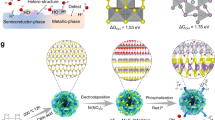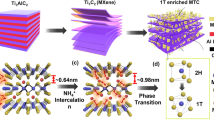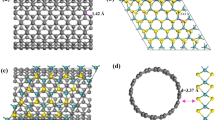Abstract
Molybdenum sulfides are very attractive noble-metal-free electrocatalysts for the hydrogen evolution reaction (HER) from water. The atomic structure and identity of the catalytically active sites have been well established for crystalline molybdenum disulfide (c-MoS2) but not for amorphous molybdenum sulfide (a-MoSx), which exhibits significantly higher HER activity compared to its crystalline counterpart. Here we show that HER-active a-MoSx, prepared either as nanoparticles or as films, is a molecular-based coordination polymer consisting of discrete [Mo3S13]2− building blocks. Of the three terminal disulfide (S22−) ligands within these clusters, two are shared to form the polymer chain. The third one remains free and generates molybdenum hydride moieties as the active site under H2 evolution conditions. Such a molecular structure therefore provides a basis for revisiting the mechanism of a-MoSx catalytic activity, as well as explaining some of its special properties such as reductive activation and corrosion. Our findings open up new avenues for the rational optimization of this HER electrocatalyst as an alternative to platinum.
This is a preview of subscription content, access via your institution
Access options
Subscribe to this journal
Receive 12 print issues and online access
$259.00 per year
only $21.58 per issue
Buy this article
- Purchase on Springer Link
- Instant access to full article PDF
Prices may be subject to local taxes which are calculated during checkout






Similar content being viewed by others
References
McKone, J. R., Lewis, N. S. & Gray, H. B. Will solar-driven water-splitting devices see the light of day? Chem. Mater. 26, 407–414 (2014).
Le Goff, A. et al. From hydrogenases to noble metal-free catalytic nanomaterials for H2 production and uptake. Science 326, 1384–1387 (2009).
Huan, T. N. et al. Bio-inspired noble metal-free nanomaterials approaching platinum performances for H2 evolution and uptake. Energy Environ. Sci. http://dx.doi.org/10.1039/C5EE02739J (2016).
McKone, J. R., Marinescu, S. C., Brunschwig, B. S., Winkler, J. R. & Gray, H. B. Earth-abundant hydrogen evolution electrocatalysts. Chem. Sci. 5, 865–878 (2014).
Andreiadis, E. S. et al. Molecular engineering of a cobalt-based electrocatalytic nanomaterial for H2 evolution under fully aqueous conditions. Nature Chem. 5, 48–53 (2013).
Jaramillo, T. F. et al. Identification of active edge sites for electrochemical H2 evolution from MoS2 nanocatalysts. Science 317, 100–102 (2007).
Kibsgaard, J., Chen, Z., Reinecke, B. N. & Jaramillo, T. F. Engineering the surface structure of MoS2 to preferentially expose active edge sites for electrocatalysis. Nature Mater. 11, 963–969 (2012).
Kong, D. et al. Synthesis of MoS2 and MoSe2 films with vertically aligned layers. Nano Lett. 13, 1341–1347 (2013).
Lukowski, M. A. et al. Enhanced hydrogen evolution catalysis from chemically exfoliated metallic MoS2 nanosheets. J. Am. Chem. Soc. 135, 10274–10277 (2013).
Morales-Guio, C. G. & Hu, X. Amorphous molybdenum sulfides as hydrogen evolution catalysts. Acc. Chem. Res. 47, 2671–2681 (2014).
Benck, J. D., Chen, Z., Kuritzky, L. Y., Forman, A. J. & Jaramillo, T. F. Amorphous molybdenum sulfide catalysts for electrochemical hydrogen production: insights into the origin of their catalytic activity. ACS Catal. 2, 1916–1923 (2012).
Jaramillo, T. F. et al. Hydrogen evolution on supported incomplete cubane-type [Mo3S4]4+ electrocatalysts. J. Phys. Chem. C 112, 17492–17498 (2008).
Kibsgaard, J., Jaramillo, T. F. & Besenbacher, F. Building an appropriate active-site motif into a hydrogen-evolution catalyst with thiomolybdate [Mo3S13]2− clusters. Nature Chem. 6, 248–253 (2014).
Merki, D., Fierro, S., Vrubel, H. & Hu, X. Amorphous molybdenum sulfide films as catalysts for electrochemical hydrogen production in water. Chem. Sci. 2, 1262–1267 (2011).
Voiry, D. et al. Enhanced catalytic activity in strained chemically exfoliated WS2 nanosheets for hydrogen evolution. Nature Mater. 12, 850–855 (2013).
Tran, P. D. et al. Novel cobalt/nickel–tungsten–sulfide catalysts for electrocatalytic hydrogen generation from water. Energy Environ. Sci. 6, 2452–2459 (2013).
Huang, Z. et al. Dimeric [Mo2S12]2− cluster: a molecular analogue of MoS2 edges for superior hydrogen-evolution electrocatalysis. Angew. Chem. Int. Ed. 54, 15181–15185 (2015).
Tran, P. D. et al. Novel assembly of an MoS2 electrocatalyst onto a silicon nanowire array electrode to construct a photocathode composed of elements abundant on the Earth for hydrogen generation. Chem. Eur. J. 18, 13994–13999 (2012).
Seger, B. et al. Hydrogen production using a molybdenum sulfide catalyst on a titanium-protected n+p−silicon photocathode. Angew. Chem. Int. Ed. 51, 9128–9131 (2012).
Morales-Guio, C. G., Tilley, S. D., Vrubel, H., Gratzel, M. & Hu, X. Hydrogen evolution from a copper(I) oxide photocathode coated with an amorphous molybdenum sulphide catalyst. Nature Commun. 5, 3059 (2014).
Hou, Y. et al. Bioinspired molecular co-catalysts bonded to a silicon photocathode for solar hydrogen evolution. Nature Mater. 10, 434–438 (2011).
Bourgeteau, T. et al. A H2-evolving photocathode based on direct sensitization of MoS3 with an organic photovoltaic cell. Energy Environ. Sci. 6, 2706–2713 (2013).
Hinnemann, B. et al. Biomimetic hydrogen evolution? MoS2 nanoparticles as catalyst for hydrogen evolution. J. Am. Chem. Soc. 127, 5308–5309 (2005).
Lauritsen, J. V. et al. Size-dependent structure of MoS2 nanocrystals. Nature Nanotech. 2, 53–58 (2007).
Lassalle-Kaiser, B. et al. Evidence from in situ X-ray absorption spectroscopy for the involvement of terminal disulfide in the reduction of protons by an amorphous molybdenum sulfide electrocatalyst. J. Am. Chem. Soc. 137, 314–321 (2015).
Bélanger, D., Laperriére, G. & Marsan, B. The electrodeposition of amorphous molybdenum sulfide. J. Electroanal. Chem. 347, 165–183 (1993).
Zhang, X. et al. Amorphous MoSxCly electrocatalyst supported by vertical graphene for efficient electrochemical and photoelectrochemical hydrogen generation. Energy Environ. Sci. 8, 862–868 (2015).
Müller, A., Wittneben, V., Krickemeyer, E., Bögge, H. & Lemke, M. Studies on the triangular cluster [Mo3S13]2−: electronic structure (Xα calculations, XPS), crystal structure of (Ph4As)2[Mo3S13]. 2CH3CN and a refinement of the crystal structure of (NH4)2[Mo3S13] ⋅ H2O. Z. Anorg. Allg. Chem. 605, 175–188 (1991).
Muller, A., Fedin, V., Hegetschweiler, K. & Amrein, W. Characterization of amorphous substances by studying isotopically labelled compounds with FAB-MS: evidence for extrusion of triangular Mo3 clusters from a mixture of 92MoS3 and 100MoS3 by reaction with OH−. J. Chem. Soc. Chem. Commun. 1795–1796 (1992).
Weber, T., Muijsers, J. C., van Wolput, J. H. M. C., Verhagen, C. P. J. & Niemantsverdriet, J. W. Basic reaction steps in the sulfidation of crystalline MoO3 to MoS2, as studied by X-ray photoelectron and infrared emission spectroscopy. J. Phys. Chem. 100, 14144–14150 (1996).
Benoist, L. et al. X-ray photoelectron spectroscopy characterization of amorphous molybdenum oxysulfide thin films. Thin Solid Films 258, 110–114 (1995).
Chiam, S. Y. et al. Investigating the stability of defects in MoO3 and its role in organic solar cells. Sol. Energy Mater. Sol. Cells 99, 197–203 (2012).
Okamura, T.-A., Tatsumi, M., Omi, Y., Yamamoto, H. & Onitsuka, K. Selective and effective stabilization of MoV I = O bonds by NH ⋯ S hydrogen bonds via trans influence. Inorg. Chem. 51, 11688–11697 (2012).
Dessapt, R. et al. Novel Mo(V)-dithiolene compounds: characterization of nonsymmetric dithiolene complexes by electrospray ionization mass spectrometry. Inorg. Chem. 42, 6425–6431 (2003).
Sugimoto, H. et al. Oxo-sulfido- and oxo-selenido-molybdenum(V I) complexes possessing a dithiolene ligand related to the active sites of hydroxylases of molybdoenzymes: low temperature preparation and characterisation. Chem. Commun. 49, 4358–4360 (2013).
Busetto, L., Vaccari, A. & Martini, G. Electron spin resonance of paramagnetic species as a tool for studying the thermal decomposition of molybdenum trisulfide. J. Phys. Chem. 85, 1927–1930 (1981).
Vrubel, H. & Hu, X. Growth and activation of an amorphous molybdenum sulfide hydrogen evolving catalyst. ACS Catal. 3, 2002–2011 (2013).
Shibahara, T. et al. Syntheses and electrochemistry of incomplete cubane-type clusters with M3S4 cores (M = Mo, W). X-ray structures of [W3S4(H2O)9](CH3C6H4SO3)4.9H2O, Na2[W3S4(Hnta)3].5H2O, and (bpyH)5[W3S4(NCS)9].3H2O. Inorg. Chem. 31, 640–647 (1992).
Weber, T., Muijsers, J. C. & Niemantsverdriet, J. W. Structure of amorphous MoS3 . J. Phys. Chem. 99, 9194–9200 (1995).
Huang, Y., Nielsen, R. J., Goddard, W. A. & Soriaga, M. P. The reaction mechanism with free energy barriers for electrochemical dihydrogen evolution on MoS2 . J. Am. Chem. Soc. 137, 6692–6698 (2015).
Li, H. et al. Activating and optimizing MoS2 basal planes for hydrogen evolution through the formation of strained sulphur vacancies. Nature Mater. 15, 48–53 (2016).
Gibney, E. The super materials that could trump graphene. Nature 522, 274–276 (2015).
Kornienko, N. et al. Operando spectroscopic analysis of an amorphous cobalt sulfide hydrogen evolution electrocatalyst. J. Am. Chem. Soc. 137, 7448–7455 (2015).
Caban-Acevedo, M. et al. Efficient hydrogen evolution catalysis using ternary pyrite-type cobalt phosphosulphide. Nature Mater. 14, 1245–1251 (2015).
Hu, X., Zhang, W., Liu, X., Mei, Y. & Huang, Y. Nanostructured Mo-based electrode materials for electrochemical energy storage. Chem. Soc. Rev. 44, 2376–2404 (2015).
Zaharieva, I. et al. Synthetic manganese-calcium oxides mimic the water-oxidizing complex of photosynthesis functionally and structurally. Energy Environ. Sci. 4, 2400–2408 (2011).
Huynh, M., Bediako, D. K. & Nocera, D. G. A functionally stable manganese oxide oxygen evolution catalyst in acid. J. Am. Chem. Soc. 136, 6002–6010 (2014).
Kanan, M. W., Surendranath, Y. & Nocera, D. G. Cobalt-phosphate oxygen-evolving compound. Chem. Soc. Rev. 38, 109–114 (2009).
Shevchenko, D., Anderlund, M. F., Thapper, A. & Styring, S. Photochemical water oxidation with visible light using a cobalt containing catalyst. Energy Environ. Sci. 4, 1284–1287 (2011).
Hutchings, G. S. et al. In situ formation of cobalt oxide nanocubanes as efficient oxygen evolution catalysts. J. Am. Chem. Soc. 137, 4223–4229 (2015).
Acknowledgements
P.D.T. and J.B. acknowledge the Energy Research Institute @ Nanyang Technological University (ERI@N) and the Singapore-Berkeley Research Initiative for Sustainable Energy (SinBeRISE) CREATE for financial and facilities supports. P.D.T. acknowledges University of Science and Technology of Hanoi for startup funding support (project USTH PECH2). Q.D.T. and I.H. acknowledge the Japan Society for Promotion of Science for financial support (Grant No. P13070). This work was supported by the French National Research Agency (Labex program, ARCANE, ANR-11-LABX-0003-01) and the European Research Council under the European Union’s Seventh Framework Programme (FP/2007–2013)/ERC Grant Agreement n.306398. J. Pérard is gratefully acknowledged for his help during ICP-AES measurements.
Author information
Authors and Affiliations
Contributions
P.D.T. and V.A. designed research and performed material synthesis and electrochemical studies. T.V.T. performed resonance Raman analysis. Q.D.T., K.N., Y.S. and I.H. performed and analysed STEM studies. S.Y.C. and R.Y. performed XPS studies. S.T. and V.A. performed and analysed EPR studies. M.O. performed DFT calculations. P.D.T., V.A. and J.B. wrote the paper.
Corresponding authors
Ethics declarations
Competing interests
The authors declare no competing financial interests.
Supplementary information
Supplementary Information
Supplementary Information (PDF 2173 kb)
Rights and permissions
About this article
Cite this article
Tran, P., Tran, T., Orio, M. et al. Coordination polymer structure and revisited hydrogen evolution catalytic mechanism for amorphous molybdenum sulfide. Nature Mater 15, 640–646 (2016). https://doi.org/10.1038/nmat4588
Received:
Accepted:
Published:
Issue Date:
DOI: https://doi.org/10.1038/nmat4588
This article is cited by
-
Phase manipulation of two-dimensional MoS2 nanostructures
Bulletin of Materials Science (2023)
-
Amorphous NiMo3S13/nickel foam integrated anode for lithium-ion batteries
Tungsten (2023)
-
Carbon-wrapped amorphous Ni–Co binary oxide nanosheet for high-performance pseudocapacitors
Applied Physics A (2023)
-
Mo3+ hydride as the common origin of H2 evolution and selective NADH regeneration in molybdenum sulfide electrocatalysts
Nature Catalysis (2022)
-
Observation of polarity-switchable photoconductivity in III-nitride/MoSx core-shell nanowires
Light: Science & Applications (2022)



